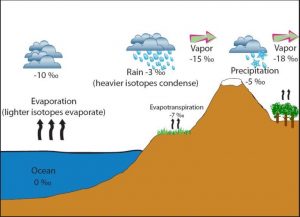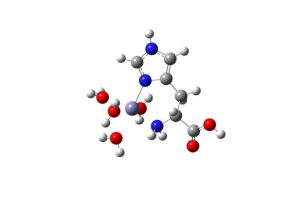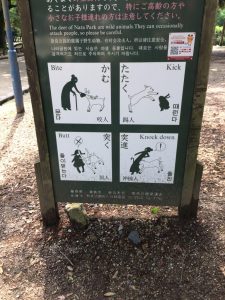Background on isotope geochemistry and DFT plus friendly deer
July 6, 2018
I’ve got a bit to cover before I can talk about what I’m working on while in Japan, so in this post, I’m going to describe a few terms and provide some background on density functional theory (DFT). Hopefully this will be informative for anyone reading who is unfamiliar with isotope geochemistry but still interesting for my colleagues! Let’s see if we can thread that needle.
What are isotopes?
An isotope of an element has the same number of protons (which defines the element), but a different number of neutrons (e.g. 1H, protium, has one proton and 2H, deuterium, has one proton and one neutron, doubling its mass while being the same element and slightly changing the properties of compounds it forms).
What is isotope fractionation?
Isotope fractionation is a term used to describe the variability in the isotopic abundances of a particular element (e.g., ratio of sulphur isotopes, 34S to 32S) among coexisting species (e.g. zinc sulphide and lead sulphide for sulphur). Without diving into too many details, higher mass isotopes tend to concentrate in molecules that are strongly held together. So, liquid water, which is more condensed and contains stronger bonds than water vapour, would be more concentrated in 2H, giving it a higher 2H/1H ratio. The bonds in water molecules containing lighter isotopes also tend to be more easily broken so are preferentially evaporated.
https://serc.carleton.edu/microbelife/research_methods/environ_sampling/stableisotopes.html
What is DFT?
DFT is a computational quantum mechanical model that provides the ground-state (total energy of electrons can’t be lowered further by transferring electrons to different orbitals) orbital geometries and vibrational frequencies of metallic compounds. Isotopes can be substituted to calculate small thermodynamic changes resulting from their substitution and the vibrational frequencies determined can then be used to estimate isotopic fractionation. In practical terms, it’s a great tool for understanding and interpreting the measurements isotope geochemists obtain!
Why am I here?
The original purpose of my trip to Japan was to visit and learn from Dr. Toshiyuki Fujii, an expert in the field of DFT estimation of isotopic fractionation. Unfortunately, he encountered some health issues shortly before the journey so alternative plans were arranged. I was really looking forward to learning from Dr. Fujii, but I’m happy to report he’s on the mend and I wish him a speedy recovery! Dr. Chizu Kato, an assistant professor who works with Dr. Fujii, was kind enough to cover for him and made arrangements for me to work with a colleague of theirs, Dr. Minori Abe, in the theoretical chemistry department of Tokyo Metropolitan University.
But Kaj, why would you subject yourself to quantum chemistry as a geologist? You only know rocks and stuff.
You’re right. Now that I’m here in Japan and learning about it, I’ve definitely had a day or two where I’ve wondered that myself. It is extremely challenging. But, it’s an incredibly useful tool that gives isotope geochemists a means of interpreting their measured results and provides us with insights into the processes that cause variability in isotopic abundances in different systems.
Optimized zinc-histidine structure created in Gaussian 09
My first exposure to the topic was when I was reading a paper that investigated a copper isotope effect in the serum of cancer patients for Dr. Kurt Kyser’s 4th year isotope geochemistry class. I was really drawn in by the research because it showed that there may be potential for using copper isotopes to detect certain types of cancer. Stable isotope geochemistry has numerous applications, but at that point I didn’t expect to find that it would have uses in medicine! This paper by Télouk et al., 2015 cited work by Dr. Fujii that used DFT to estimate the isotopic fractionation of lactate-bound copper compared to copper bound to different amino acids (building blocks of proteins) and provided an explanation for the copper isotopic composition measured in in the serum of cancer patients. Lactate, which most of us know to cause pain in our muscles when we run for extended periods (and sometimes short periods), is produced by cancer cells and forms strong bonds with copper. Dr. Fujii’s work was able to be used to show that the copper isotopic composition measured in serum of cancer patients more closely matched an isotopic effect theoretically estimated for copper-lactate formation in cancer cells than other processes. I thought this was incredibly cool so I stashed DFT away in my head as something I’d like to learn if the opportunity came along.
Learning to perform DFT calculations hasn’t been easy so far, but I’m learning a lot each day and will take a great amount away from this trip. With a better understanding of the merits and limitations of the method, I’ve already been given new ideas for projects and ways to approach my research in the future. As a side note before I go, I am incredibly lucky that Dr. Abe agreed to work with me on such short notice. With me being a complete novice in this field, Dr. Abe might have taken on more than she bargained for!
In my next post, I’ll finally get into some details about my time with Dr. Kato and Dr. Abe and what my work entails.
Until next time,
Kaj
P.S. For those interested in meeting some tiny deer for themselves, over one thousand of them can be found in Nara Park, just east of Osaka. But be careful.





